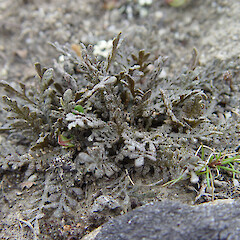Lepidium solandri
Common name
Maniototo peppercress
Synonyms
L. sisymbrioides subsp. solandri (Kirk) Thell., L. sisymbrioides subsp. solandri var. typicum Thell., Lepidium matau Petrie, Lepidium sisymbrioides subsp. matau var. lobulatum Thell., Lepidium sisymbrioides subsp. matau (Petrie) Thell.
Family
Brassicaceae
Flora category
Vascular – Native
Endemic taxon
Yes
Endemic genus
No
Endemic family
No
Structural class
Herbs - Dicotyledons other than Composites
NVS code
The National Vegetation Survey (NVS) Databank is a physical archive and electronic databank containing records of over 94,000 vegetation survey plots - including data from over 19,000 permanent plots. NVS maintains a standard set of species code abbreviations that correspond to standard scientific plant names from the Ngä Tipu o Aotearoa - New Zealand Plants database.
LEPSOL
Current conservation status
The conservation status of all known New Zealand vascular plant taxa at the rank of species and below were reassessed in 2017 using the New Zealand Threat Classification System (NZTCS) – more information about this can be found on the NZTCS website. This report includes a statistical summary and brief notes on changes since 2012 and replaces all previous NZTCS lists for vascular plants.
Please note, threat classifications are often suggested by authors when publications fall between NZTCS assessment periods – an interim threat classification status has not been assessed by the NZTCS panel.
- Conservation status of New Zealand indigenous vascular plants, 2017 . 2018. Peter J. de Lange, Jeremy R. Rolfe, John W. Barkla, Shannel P. Courtney, Paul D. Champion, Leon R. Perrie, Sarah M. Beadel, Kerry A. Ford, Ilse Breitwieser, Ines Schönberger, Rowan Hindmarsh-Walls, Peter B. Heenan and Kate Ladley. Department of Conservation. Source: NZTCS and licensed by DOC for reuse under the Creative Commons Attribution 4.0 International licence.
2017 | Threatened – Nationally Critical | Qualifiers: RF, Sp
Previous conservation statuses
2012 | Threatened – Nationally Endangered | Qualifiers: DP, Sp
2009 | Threatened – Nationally Endangered | Qualifiers: DP
2004 | Threatened – Nationally Critical
Distribution
Endemic. New Zealand: South Island (east of the main divide from North Canterbury to Central Otago (Galloway district, Manuherikia Valley)).
Habitat
Short and tall tussock grassland, bare hillsides, salt pans, grey scrub and other poorly vegetated ground. On open clay or salt pans, limestone talus, gravel veneers overlying schist, mudstone, or eroded silts and clays.
Detailed description
Perennial dioecious herb, with up to 24 compact, leafy rosettes. Rootstock deep rooted, up to 28 mm diam. near crown; stems spreading to erect, up to 60 mm long, 10.0 mm wide. Basal and lower stem leaves persistent, pinnatifid, pinnate, to bipinnatifid, narrow-oblong to oblong, up to 100 mm long, green, green-brown, or brown, central part of lamina 0.7–6.2 mm wide; pinnae in 14–32 pairs, linear, obovate or broadly oblong, with up to 5 secondary pinnae, terminal pinnae 3.0–16.0 × 1.0–4.9 mm, lateral pinnae 2.6–11.3 x 0.8–3.9 mm. Middle stem leaves similar, often becoming shallowly pinnatifid, serrate, or entire. Cauline leaves 2.5–19.8 × 1.2–9.8 mm, with up to 3 serrations or small lobes, or entire. Inflorescences terminal, 1.5–16.0 cm long, 0.8–3.7 mm diameter at base, usually spreading to ascending, with up to 12 lateral branches, glabrous to sparsely hairy; pedicels 2.5– 6.5 mm long, 0.2–0.35 mm wide, slightly recurved, adaxial surface glabrous to moderately hairy, abaxial surface glabrous to rarely sparsely hairy. Flowers up to 4 mm wide. Sepals 0.7–1.3 × 0.7–1.6 mm, green to maroon, sparsely to moderately hairy, rarely glabrous, margins scarious, apex obtuse. Petals usually absent, rarely present and then clawed, white, limb obovate, apex emarginate; males: 1.3–1.5 mm long; females: 0.8–1.1 mm long. Female flowers: ovary 1.0–2.4 × 1.1–1.8 mm, usually orbicular to rhomboid, sometimes ovate, sparsely to moderately hairy, rarely glabrous; style up to 0.1–0.4 mm long; stigma 0.3–0.4 mm wide; 3–7 staminodes, 0.8–1.4 mm long, rarely with malformed anthers to 0.3 mm long. Male flowers: 4–6 stamens, 1.5–2.8 mm long, white; anthers 0.3–0.6 mm long, white or maroon; ovary rudimentary, 0.2–1.1 x 0.3–1.3 mm. Nectaries 0.25–0.5 mm long, green, green-red, to red, oblong. Siliques 3.1–5.0 x 2.3–3.8 mm, usually orbicular to rhomboid, sometimes ovate, suture usually maroon, apex emarginate to retuse, style base often persistent. Seed usually obovate, rarely obovateoblong, straighter along one margin, compressed but with broad rounded margins, 1.7–2.5 mm long, not winged; both surfaces with a distinct groove from hilum at base towards apex, and the seed folded around it; apex broad and rounded; base cuneate or slightly rounded. Testa dull, orange or orange-brown to dark henna, with a fine reticulum of very thickwalled cells.
Similar taxa
Distinguished from Lepidium sisymbrioides by shorter, wider cauline leaves, shorter terminal and primary pinnae with less frequent secondary lobing; more hairy sepals and ovaries; broader ovaries; longer stamen filaments; and ecology.
Flowering
September–January
Flower colours
Green, White
Fruiting
September–February
Life cycle
Mucilaginous seeds are dispersed by attachment and possibly wind and water (Thorsen et al., 2009).
Propagation technique
Easily grown from fresh seed.
Threats
Less than 1000 plants are known in the wild. Few sites protected. All sites threatened by weed competition, animal browsing, and for most sites changes in land-use management.
Etymology
lepidium: Scale-shaped (pods)
solandri: Named after Daniel Carlsson Solander (19 February 1733 - 13 May 1782) who was a Swedish naturalist and an apostle of Carl Linnaeus.
Where To Buy
Not commercially available.
Attribution
Description from: Heenan et al 2007.
References and further reading
Allen RB. 2000. Inland Lepidium recovery plan 2000–2010. Threatened Species Recovery Plan 32. Department of Conservation, Wellington, NZ. 25 p.
Heenan PB, Mitchell AD, McLenachan PA, Lockhart PJ, de Lange PJ. 2007. Natural variation and conservation of Lepidium sisymbrioides Hook.f. and L. solandri Kirk (Brassicaceae) in South Island, New Zealand, based on morphological and DNA sequence data. New Zealand Journal of Botany 45(1): 237–264. https://doi.org/10.1080/00288250709509712.
Thorsen MJ, Dickinson KJM, Seddon PJ. 2009. Seed dispersal systems in the New Zealand flora. Perspectives in Plant Ecology, Evolution and Systematics 11: 285–309. https://doi.org/10.1016/j.ppees.2009.06.001.












